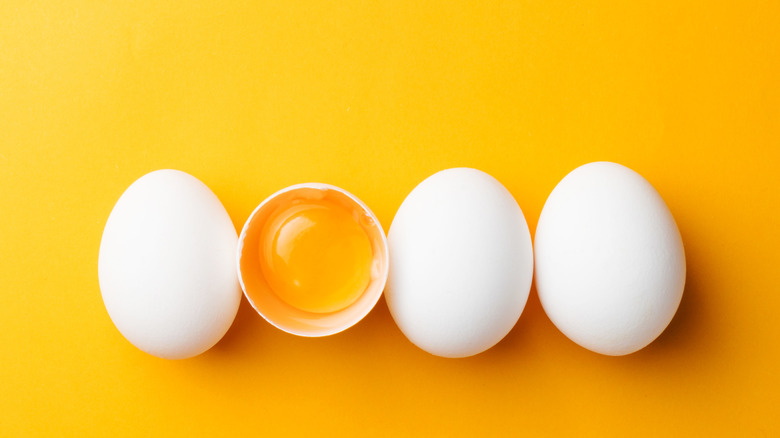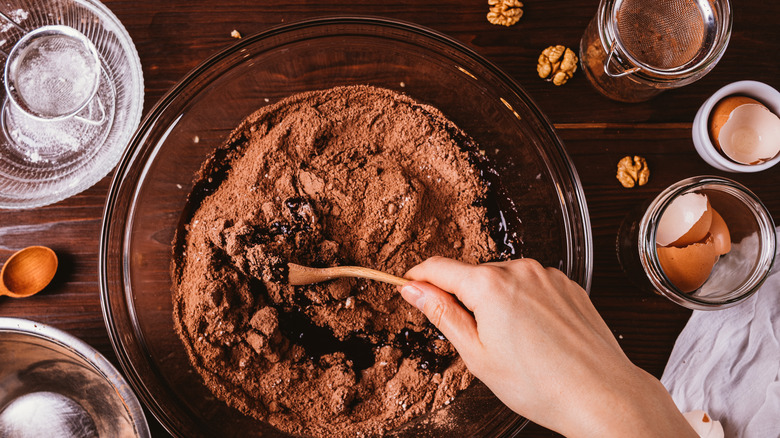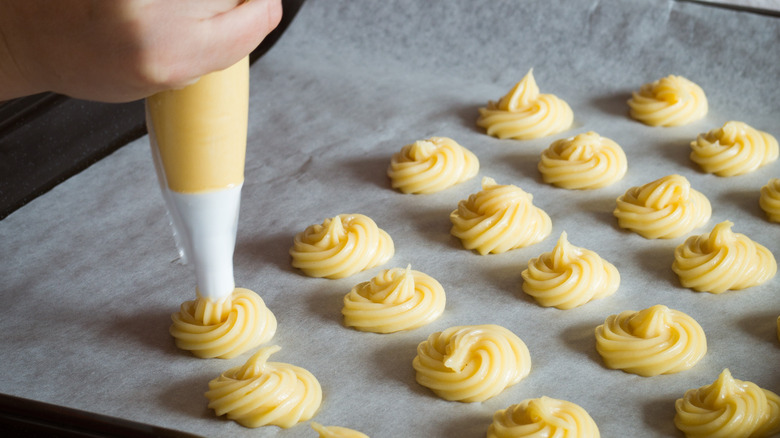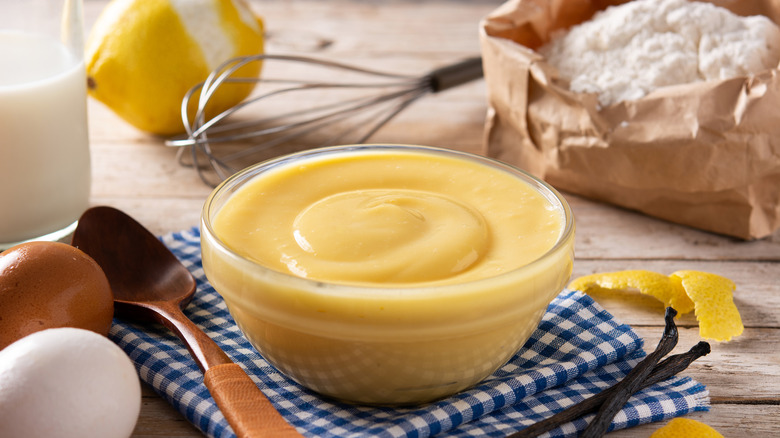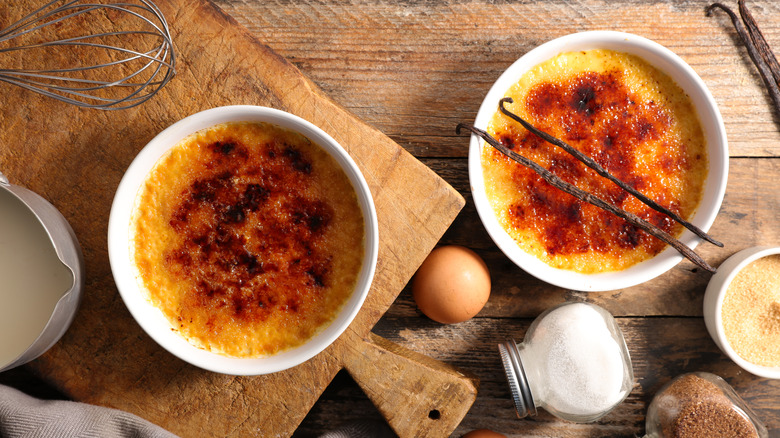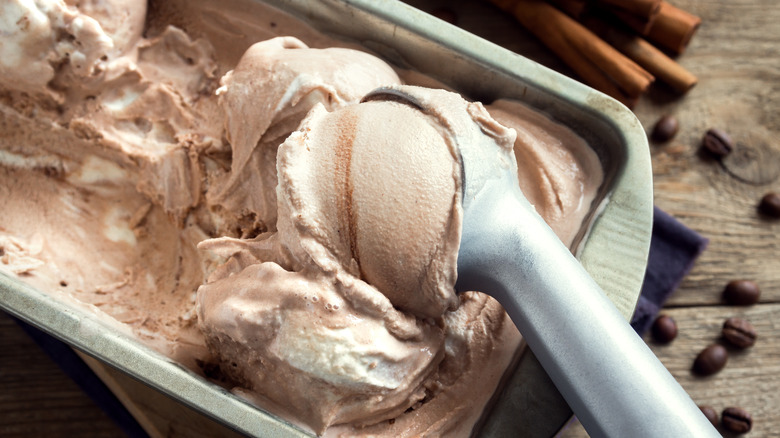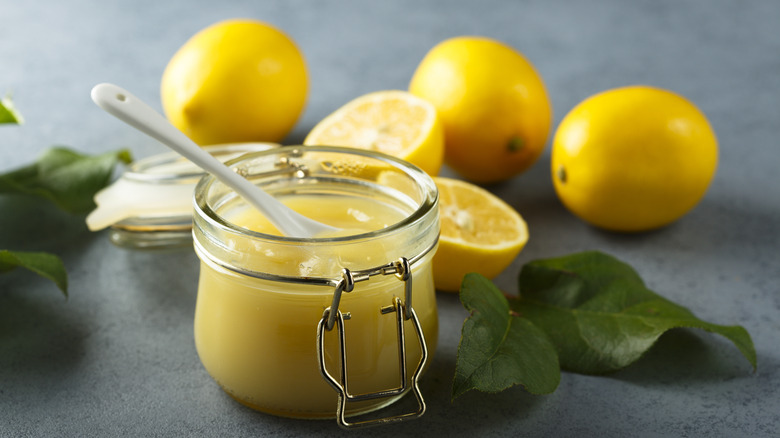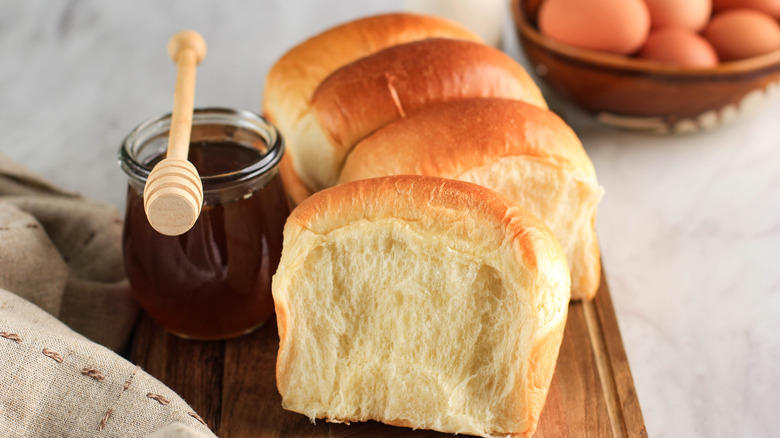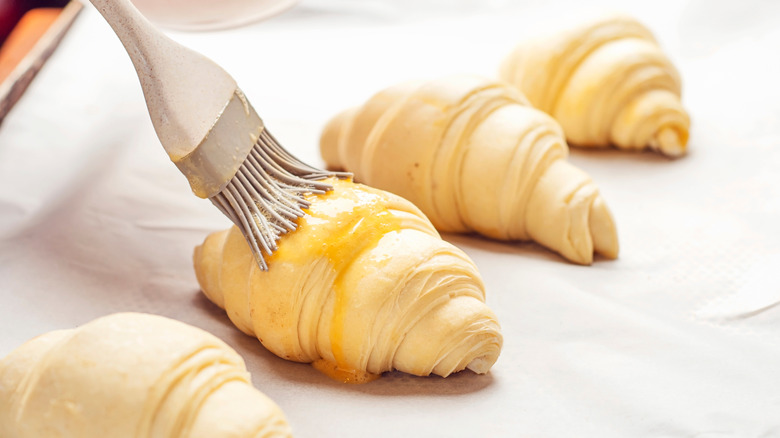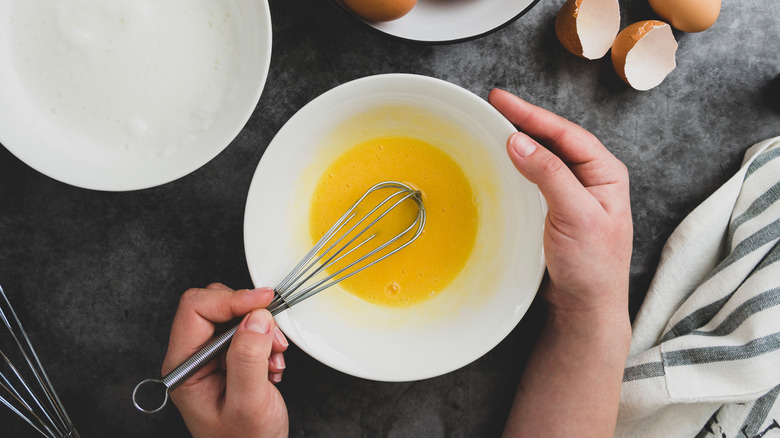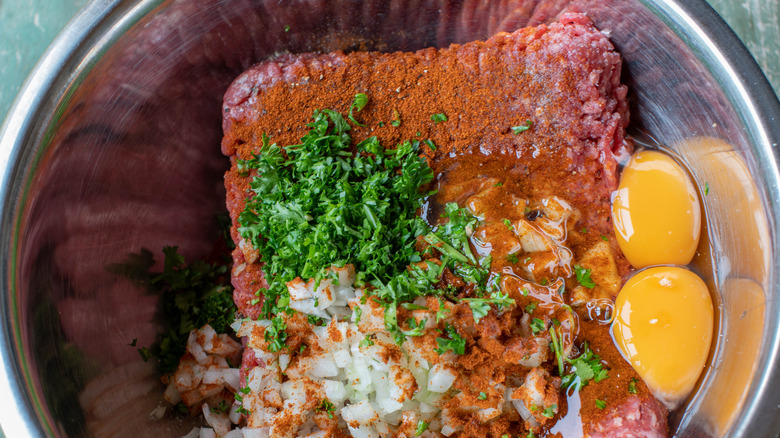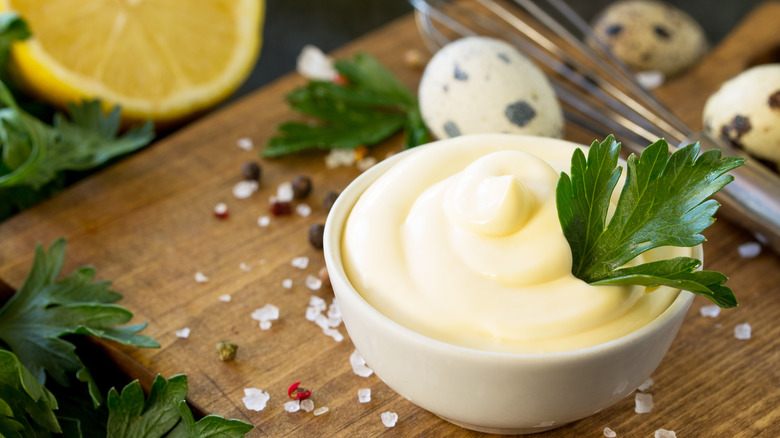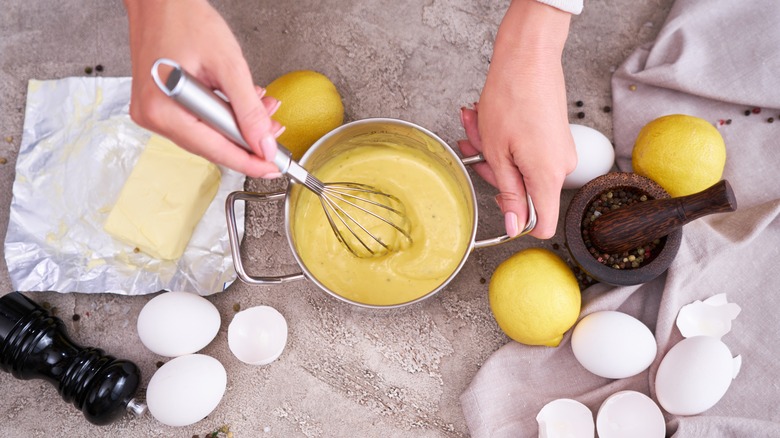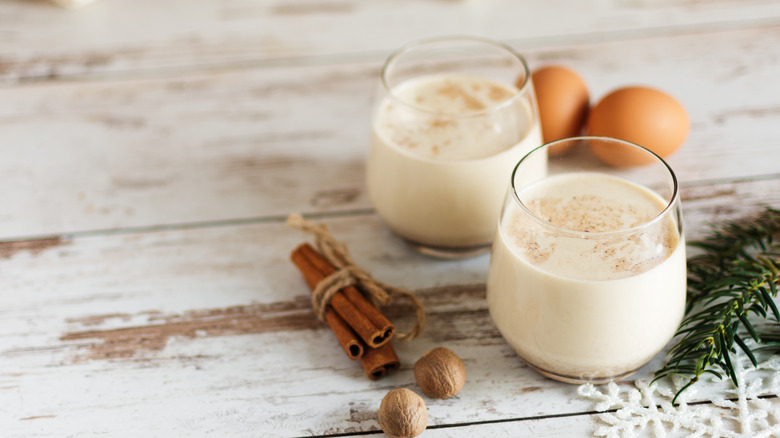13 Best Ways To Use Leftover Egg Yolks
You just finished a batch of fluffy frosting or airy meringues, and now you have a bunch of leftover egg yolks sitting idly in a bowl, waiting to be transformed. What can you make with the extras? Eggs are possibly the most versatile ingredient in the kitchen. With their unique properties, they play a crucial role in baking as well as in making rich, creamy sauces and luxurious desserts.
Eggs, specifically egg yolks, can be kept for up to two days in the refrigerator as leftovers and frozen to use as needed (via The Incredible Egg). They are essential elements in cooking that provide structure, texture, color, and flavor to bread, brownies, cookies, custards, sauces, and more. The ingredient gives savory hand pies a glossy finish, adheres a crispy coating to a juicy chicken breast, and helps bind a hearty meatloaf. From adding moisture to your baked goods to emulsifying a rich, creamy sauce, the uses for leftover egg yolks are numerous and diverse.
1. Add richness to baked goods
From chewy cookies to fudgy brownies, there are a few key ingredients almost every recipe calls for, such as flour, butter, and of course, eggs. When it comes to baking, eggs play a critical role in the finished product's flavor, texture, and consistency. According to Baking Kneads, the yolks serve several purposes, from adding structure to retaining richness. Egg yolks enrich cookies and other baked goods with extra fat, resulting in a moist, chewy cookie or brownie.
While egg whites have a natural drying effect, the yellow centers will keep your cookies, cakes, and brownies tender. Even before the dough is baked, the yolks begin their work. As the ingredients are mixed, they begin to emulsify into a creamy dough that yields soft, decadent baked goods. Simply adding one leftover egg yolk to your batter can elevate its texture from dry and crumbly to rich and moist.
2. Make some pastry dough
The pastry world is both vast and complex, often taking years of study for bakers and chefs to master. Whether crafted in a French patisserie or your grandmother's kitchen, many types of pastries share similar ingredients while varying in style and technique. As in most baked goods, eggs play a critical role in the structure and temperament of certain forms of pastry dough.
Pâte à choux, also known as choux pastry, is a common dough used to make elegant desserts such as cream puffs, éclairs, and profiteroles, as well as savory gougères. This unique, twice-cooked mix requires eggs to achieve its signature airy center and crisp exterior. Both parts of the egg are key to developing a successful choux pastry. The yolks add fat and moisture as well as heat-sensitive proteins that provide structure and integrity to the finished product, while the egg whites maintain a firm outer shell. Some recipes also call for an extra yolk to use as an egg wash for a beautifully browned finish.
3. Prepare pastry cream
Pastry cream is a staple filling for a wide range of decadent treats such as cakes, tarts, éclairs, and other pastries. Memorizing how to prepare this sumptuous custard is something seasoned chefs such as Alton Brown consider a must for chefs and home cooks alike. This pastry cream is made with milk, eggs, sugar, and cornstarch to create a luscious complement to spongy cakes and flaky pastries.
As mentioned by The Flavor Bender, egg yolks are critical to creating the smooth, thick texture of the cream. Slowly tempering eggs, sugar, and cornstarch with hot milk allows the mixture to achieve a heavier consistency, resulting in a robust custard that can then be flavored to suit the baker's purpose. Its signature viscosity and the ability to be easily piped make the recipe a popular choice of filling for various baked goods such as cream puffs, fruit tarts, and Boston cream pie.
4. Whip up some custard
Custard desserts can be found in nearly every corner of the world. From Mexico's silky flan and Chinese egg tarts to Brazilian quindim and France's iconic crème brûlée, these luscious treats all rely on the thickening properties imbued by generous amounts of egg yolks. In fact, it is this ingredient that sets custard apart from other creamy desserts, such as puddings. As the protein in the yolk begins to break down, the liquid grows firmer, giving custard its structural integrity and distinct, velvety texture.
The key to successful yolk-based custard is heating it low and slow. Many recipes use a water bath or double-boiler to ensure gentle, even cooking to prevent the eggs from coagulating too quickly. Additional yolks make the custard extra luscious while also acting as a thickener. Once this technique is mastered, leftover egg yolks can be transformed into a wide variety of creamy custard desserts, from Spanish crema Catalana to a classic English trifle.
5. Make homemade ice cream
While most people simply pick up their favorite pint in the frozen aisle at the grocery store, homemade ice cream is a delicious way to use leftover egg yolks. The thickening and emulsifying properties of the yellow ingredient bring flavor, stability, and texture to the cold dessert. Because fat remains softer than water when it freezes, yolks help keep the ice cream soft and smooth after freezing.
As described by Ice Cream Calculator, egg yolks contribute emulsifiers, such as lecithin, that bind the fat to the water and stabilize the custard base, minimizing the formation of ice crystals during freezing while also helping the dessert keep its texture and shape. When mixed with milk and cream, they play a critical role in creating the right consistency in the ice cream machine to achieve the desired consistency. Next time you have leftover egg yolks, skip store-bought and satisfy your craving with rich, homemade ice cream.
6. Turn them into curd
Bright, tangy fruit curd is a beloved ingredient, especially in British cuisine, for pies, bars, scones, tarts, and other desserts and tea-time treats. Although lemon may be the most iconic version of this luscious spread or filling, it can be made with a wide variety of fruits such as berries, passion fruit, and other citrus fruits, including limes, oranges, or grapefruit. Fruit curd is typically made with just a few ingredients, primarily egg yolks, butter, sugar, and fruit juice. (Citrus fruits are popular because the tart acidity balances the creamy richness of the butter and yolks.) However, it is the technique that can make or break your silky, smooth recipe.
Because of the high content of egg yolks, classic curd should be heated slowly to prevent them from curdling too quickly, leaving unpleasant chunks of cooked egg that must be strained. While the recipe is traditionally prepared using a double-boiler method, Chef Tara Rylie uses the microwave to minimize the time and difficulty of preparing it fresh.
7. Enrich your bread dough
While basic bread recipes need only flour, water, salt, and yeast, pillowy enriched bread such as challah and brioche are coveted for their soft, airy texture and golden brown finish. The secret ingredient to these tender, buttery loaves is the addition of generous amounts of fat from butter and, of course, eggs. As in custards and curds, eggs are essential to enriched bread dough.
Busby's Bakery explains that the added protein from the egg supports the gluten in the bread, creating air pockets that assist with the dough's rising. The ingredient's emulsifying properties (featured in the egg yolks) strengthen the gluten bonds to form a more cohesive and elastic dough. These processes are critical to creating a light and fluffy loaf with a rich, rounded flavor. The fat from the yolks also helps soften the end product and caramelize the crust, giving the loaf a tender, shiny, golden-brown finish.
8. Use them as an egg wash
For the same reason bakers rely on eggs to help caramelize the crust of enriched bread dough, cooks use an egg wash to enhance bread, pastries, rolls, and more with a rich color and glossy finish. A basic combination can be as simple as beating egg yolks with a splash of milk or water, then brushing the mixture over your formed dough before baking. Adding milk or cream to the egg wash results in an even deeper brown color, while a buttery glaze will aid in keeping the crust soft and tender. An extra yolk in the wash will give the pastry a rich, glossy finish.
With both sweet and savory applications, the versatility of egg wash goes beyond creating a shiny crust. Use the mixture to seal the edges of hand pies, empanadas, and wonton dumplings or brush over meat to promote browning and adhere seasonings. This simple technique will both use up leftover egg yolks and elevate the appearance and texture of your homemade baked goods.
9. Add them to a breading
The standard breading procedure is a foundational cooking technique for creating a crispy exterior on meats, tofu, vegetables, and more (via Jessica Gavin). The process is a tried and true strategy used in various popular dishes such as fried chicken, chicken katsu, and mozzarella sticks. First, the ingredient to be breaded is coated in a dry layer, usually of seasoned flour, then is dipped in an egg wash mixture. The initial dusting of flour helps the egg wash stick.
After the egg wash, the item is then finished with an additional dry layer of flour, breadcrumbs, or another crunchy coating. The protein in the egg yolk binds the ingredients while aiding in the browning process during cooking. To add flavor and texture to a dish, plain breadcrumbs could be replaced with other crunchy ingredients such as finely chopped nuts, cornflakes, cracker crumbs, or crushed potato chips.
10. Use them as a binder
Thanks to their thickening and coagulating properties, eggs, and their yolks, make excellent binders for meats and fillings. You will often find eggs included in recipes for meatloaf, meatballs, potato latkes, vegetable patties, and more because of their ability to hold ingredients together during the cooking process.
While some purists recoil at the thought of adding an egg to a burger patty, Best Burger Guide concedes that some meat blends require an egg binder to achieve the desired level of consistency and cohesion. The inclusion of an egg homogenizes the meat mixture and promotes even cooking. For leaner ground meats, such as poultry, including eggs in the mix increases fat and moisture, keeping it juicy and flavorful. The extra fat from adding a leftover egg yolk helps round it out by improving the texture and flavor of the patty or meatballs.
Quick and easy vegetable patties are another great way to clean out the fridge by using leftover yolks, vegetables, and herbs. Simply shred vegetables such as zucchini, carrots, or potatoes and add seasonings and aromatics like herbs, garlic, and onions, along with your leftover egg yolk, then mix, shape, and pan fry until crisp on the edges and cooked through the middle.
11. Whip up homemade mayonnaise
Mayonnaise is a fascinating condiment with a wide range of applications in the kitchen. The versatile sauce is created by activating the chemical process that binds key ingredients together to form the signature creamy spread. Mayonnaise is an emulsion in which the protein from egg yolks denatures and clings to added oil, thickening the sauce. To prevent the mixture from separating, the ingredients must be added at the right time and in the right order. Mayonnaise is surprisingly easy to make at home and a great way to use leftover egg yolks, the key ingredient of this creamy condiment.
To make mayonnaise at home, whisk the egg yolks in a bowl, followed by a little oil, added slowly to activate the process. Next, whisk in a little acid, such as vinegar or lemon juice, then gradually drizzle in the remaining oil, whisking throughout the entire process. Season with salt and more acid if needed. A basic mayonnaise recipe can be enhanced with flavors and add-ins such as mustard, garlic, or smoked paprika. Once you have prepared your homemade condiment, use it as a spread, dressing, dip, or sauce.
12. Prepare some hollandaise
Like mayonnaise, hollandaise is an egg yolk-based sauce made through emulsification. A notoriously tricky dressing to master, luxurious hollandaise is often served with sautéed asparagus or draped over Eggs Benedict. Home cooks often shy away from the sauce due to its finicky nature and the ease with which it may separate or break. This occurs when the yolks cook too quickly, or the emulsifying agents are added incorrectly.
In a broken hollandaise, the texture will appear grainy and watery with fats that have visibly separated from the other liquids. However, all is not lost if your sauce has broken. According to Science of Cooking, "The Inquisitive Cook" recommends whisking the hollandaise into another beaten egg yolk immediately before serving to re-emulsify a sauce that has separated. While the classic preparation involves slowly drizzling warm butter into an egg yolk and lemon juice mixture while furiously whisking, innovative cooks have discovered quick hacks for preparing creamy hollandaise without separation. A hollandaise sauce pairs well with rich proteins like salmon or steak and sturdy vegetables such as broccoli or Brussels sprouts.
13. Enjoy a mug of egg nog
Employ leftover egg yolks to impress at your next holiday party with homemade eggnog. The festive drink is rich with milk and eggs seasoned with a dash of nutmeg, often finished with a splash of rum, bourbon, or a combination of spirits. Gently tempered eggs give this traditional Yuletide beverage its signature viscosity and velvety texture. Whipped egg whites are key for an ideal eggnog that is silky on the bottom with a light, foamy top, along with cooking the egg yolks low and slow, just like most egg-based custards and sauces.
Much like hollandaise, preparing eggnog is a delicate process. If the booze is added too abruptly or at too high a temperature, disaster could strike, turning the smooth, creamy nog into a lumpy, curdled mess. Although they can be temperamental, the unique properties of eggs and their yolks yield undeniably decadent results. From luscious custards to the iconic boozy holiday beverage, the ingredient holds nearly endless possibilities once you know how to use them.
